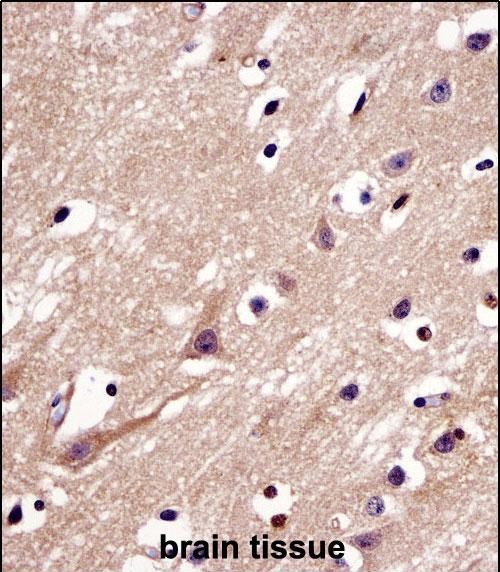MGARP Antibody (C-term)
Affinity Purified Rabbit Polyclonal Antibody (Pab)
- SPECIFICATION
- CITATIONS
- PROTOCOLS
- BACKGROUND

Application
| WB, IHC-P, E |
|---|---|
| Primary Accession | Q8TDB4 |
| Other Accession | NP_116012.2 |
| Reactivity | Human |
| Host | Rabbit |
| Clonality | Polyclonal |
| Isotype | Rabbit IgG |
| Calculated MW | 25390 Da |
| Antigen Region | 176-204 aa |
| Gene ID | 84709 |
|---|---|
| Other Names | Protein MGARP, Corneal endothelium-specific protein 1, CESP-1, Hypoxia up-regulated mitochondrial movement regulator protein, Mitochondria-localized glutamic acid-rich protein, Ovary-specific acidic protein, MGARP, C4orf49, CESP1, HUMMR, OSAP |
| Target/Specificity | This C4orf49 antibody is generated from rabbits immunized with a KLH conjugated synthetic peptide between 176-204 amino acids from the C-terminal region of human C4orf49. |
| Dilution | WB~~1:1000 IHC-P~~1:10~50 E~~Use at an assay dependent concentration. |
| Format | Purified polyclonal antibody supplied in PBS with 0.09% (W/V) sodium azide. This antibody is purified through a protein A column, followed by peptide affinity purification. |
| Storage | Maintain refrigerated at 2-8°C for up to 2 weeks. For long term storage store at -20°C in small aliquots to prevent freeze-thaw cycles. |
| Precautions | MGARP Antibody (C-term) is for research use only and not for use in diagnostic or therapeutic procedures. |
| Name | MGARP |
|---|---|
| Synonyms | C4orf49, CESP1, HUMMR, OSAP |
| Function | Plays a role in the trafficking of mitochondria along microtubules. Regulates the kinesin-mediated axonal transport of mitochondria to nerve terminals along microtubules during hypoxia. Participates in the translocation of TRAK2/GRIF1 from the cytoplasm to the mitochondrion. Also plays a role in steroidogenesis through maintenance of mitochondrial abundance and morphology (By similarity). Plays an inhibitory role during neocortex development by regulating mitochondrial morphology, distribution and motility in neocortical neurons (By similarity). |
| Cellular Location | Mitochondrion. Mitochondrion outer membrane {ECO:0000250|UniProtKB:Q8VI64}; Single-pass type IV membrane protein {ECO:0000250|UniProtKB:Q8VI64}; Cytoplasmic side {ECO:0000250|UniProtKB:Q8VI64}. Mitochondrion inner membrane {ECO:0000250|UniProtKB:Q8VI64}; Single-pass type IV membrane protein {ECO:0000250|UniProtKB:Q8VI64}; Cytoplasmic side {ECO:0000250|UniProtKB:Q8VI64}. Note=Colocalizes with RHOT1, RHOT2, TRAK1 and TRAK2 at the mitochondrion. {ECO:0000250|UniProtKB:Q8VI64} |
| Tissue Location | Expressed in the brain, adrenal gland and corneal endothelium (CE). Expressed in steroid-producing cells of the ovary and testis (at protein level). Expressed in steroid-producing cells of the ovary and testis. Weakly expressed in placenta. Expressed in corneal endothelial cells. |

Thousands of laboratories across the world have published research that depended on the performance of antibodies from Abcepta to advance their research. Check out links to articles that cite our products in major peer-reviewed journals, organized by research category.
info@abcepta.com, and receive a free "I Love Antibodies" mug.
Provided below are standard protocols that you may find useful for product applications.
Background
The function of this protein remains unknown.
References
Matsumoto, T., et al. Endocrinology 150(7):3353-3359(2009)
Li, Y., et al. J. Cell Biol. 185(6):1065-1081(2009)
Kinouchi, R., et al. Invest. Ophthalmol. Vis. Sci. 47(4):1397-1403(2006)
Sakai, R., et al. Invest. Ophthalmol. Vis. Sci. 43(6):1749-1756(2002)
If you have used an Abcepta product and would like to share how it has performed, please click on the "Submit Review" button and provide the requested information. Our staff will examine and post your review and contact you if needed.
If you have any additional inquiries please email technical services at tech@abcepta.com.













 Foundational characteristics of cancer include proliferation, angiogenesis, migration, evasion of apoptosis, and cellular immortality. Find key markers for these cellular processes and antibodies to detect them.
Foundational characteristics of cancer include proliferation, angiogenesis, migration, evasion of apoptosis, and cellular immortality. Find key markers for these cellular processes and antibodies to detect them. The SUMOplot™ Analysis Program predicts and scores sumoylation sites in your protein. SUMOylation is a post-translational modification involved in various cellular processes, such as nuclear-cytosolic transport, transcriptional regulation, apoptosis, protein stability, response to stress, and progression through the cell cycle.
The SUMOplot™ Analysis Program predicts and scores sumoylation sites in your protein. SUMOylation is a post-translational modification involved in various cellular processes, such as nuclear-cytosolic transport, transcriptional regulation, apoptosis, protein stability, response to stress, and progression through the cell cycle. The Autophagy Receptor Motif Plotter predicts and scores autophagy receptor binding sites in your protein. Identifying proteins connected to this pathway is critical to understanding the role of autophagy in physiological as well as pathological processes such as development, differentiation, neurodegenerative diseases, stress, infection, and cancer.
The Autophagy Receptor Motif Plotter predicts and scores autophagy receptor binding sites in your protein. Identifying proteins connected to this pathway is critical to understanding the role of autophagy in physiological as well as pathological processes such as development, differentiation, neurodegenerative diseases, stress, infection, and cancer.



